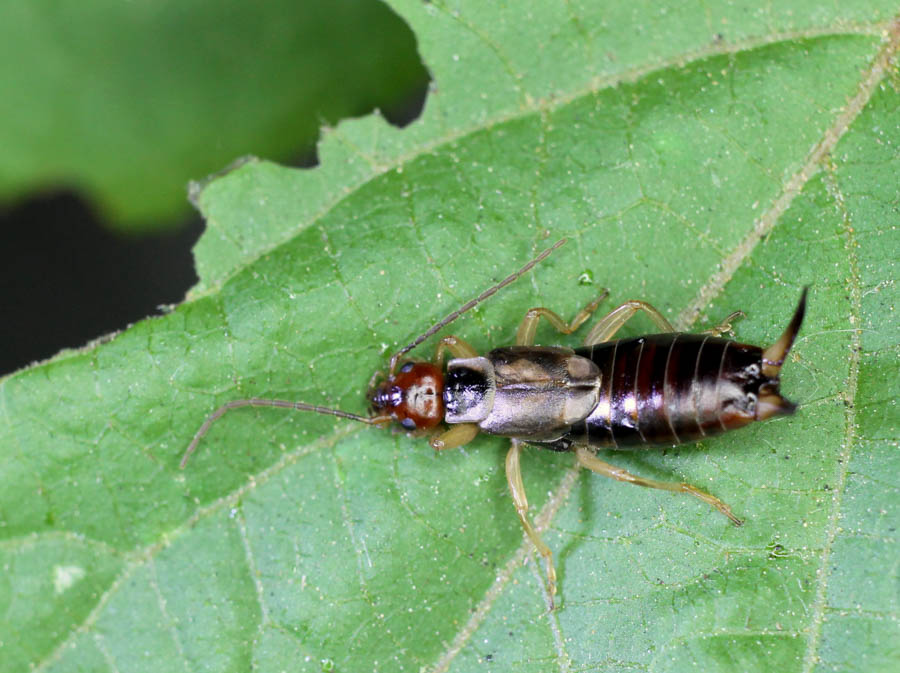Down and Dirty 10: Earwigs Are Fickle Allies in the Garden

Down and Dirty Southern California Gardening
A weekly GardenZeus article series to help gardeners succeed in Southern California’s unique climates and growing conditions.
Post 10: Earwigs Are Fickle Allies in the Garden
I have heard stories of people experiencing a sharp pain inside an ear and pulling out an earwig a piece at a time; or a person feeling something odd inside the mouth after eating a fresh fruit, say a peach or apricot, and pulling out half an earwig. (What’s worse than finding an earwig in your mouth? Finding half an earwig.) Earwigs don’t actively seek to engage with or harm people, and apart from the possibility of a sharp pinch if they are trapped or threatened, most human encounters with earwigs are likely to be harder on the earwigs than the humans.
Earwigs are notable among insects in their ability to put themselves into the oddest of places, not just compost piles and bathtubs, and not just the occasional human mouth or ear, but almost anywhere moisture collects including in sink drains, hoses, and almost any nook or cranny indoors or outdoors. Gardeners may be unaware that many species of earwigs have wings and are able to fly, but most do so only rarely.
Earwigs may end up in shoes or boots, especially those left on a doorstep near plants that are regularly irrigated or by an area that stays moist, and they may crawl under clothing when looking for places to hide or rest during the day, perhaps occasionally when you happen to be inside the clothing. They typically enter houses and structures to avoid hot or cold weather, or when looking for moisture rather than food, and they usually don’t survive well or for long periods inside human homes.
Several species of earwigs are found in California gardens. The European earwig (pictured above) is the most common. It’s a voracious predator of aphids, and also eats mites, aphid eggs, and other insect eggs. Not all earwigs eat garden plants. The European earwig prefers a varied diet including your garden seedlings to the point of stripping them down to sad, lonely stubs; a wide variety of new plant growth; most berries; soft fruits such as stone fruits; the silks on sweet corn; and flowers such as dahlias and zinnias.
Like all insect and other garden pests, what earwigs eat also depends on available food sources and how hungry they are, I have occasionally seen them cause serious damage to snap peas by burrowing into pea pods and eating young peas. If preferred and easy food sources aren’t available or during infestations, earwigs will expand their menu options to include mature foliage on many vegetables and herbs and almost any soft plant matter.
Earwigs are fickle garden allies. I maintain an uneasy peace with them, like with guests that are on the verge of overstaying their welcome (although I also view myself as a guest in the environment and garden that we both inhabit). They tend to be less a problem in hot-summer California areas and more a problem in year-round mild-climate areas.
I recommend that you leave earwigs alone if you see only a few here and there in your garden. Within reason they’re welcome to nibble on my plants and berries, and I appreciate the benefit they provide in controlling aphids. They become a serious annoyance or problem when they reach high population density, approach infestation, or during periods of environment stress or seasonal transition when food sources are limited or outdoor earwig habit has dried up and they’re highly mobile looking for new habitat. They are most often a problem when garden conditions provide ideal habitat, which includes shade, moisture, and cool temperatures.
If you see only an occasional earwig in your home or garden, you might consider capturing it in a jar or small container, and taking it outside to put it onto a plant or into a garden area that has been prone to aphids. The small black Argentinian ants that are common throughout California will attack and fend off earwigs to protect aphids, so that the ants can harvest the sweet honeydew sugar-water that aphids excrete. You may need to control ants before earwigs and other beneficials will feed on aphids.
In Down and Dirty 11: Nontoxic Habitat Traps for Earwigs (Coming Soon) I will discuss more about earwig habitat and nontoxic management of infestations in the home garden.
“Down and Dirty Southern California Gardening” is a weekly GardenZeus article series in which expert Darren Butler shares more than 20 years of experience about what works and what doesn’t with gardening in Southern California:
Post 9: Insect Pests and Diseases Usually Aren’t the Problem
Post 11: Nontoxic Habitat Traps for Earwigs
All articles in this series: Down and Dirty Southern California Gardening
GardenZeus Calfornia climate zones
Enter your California zip code for customized advice by plant